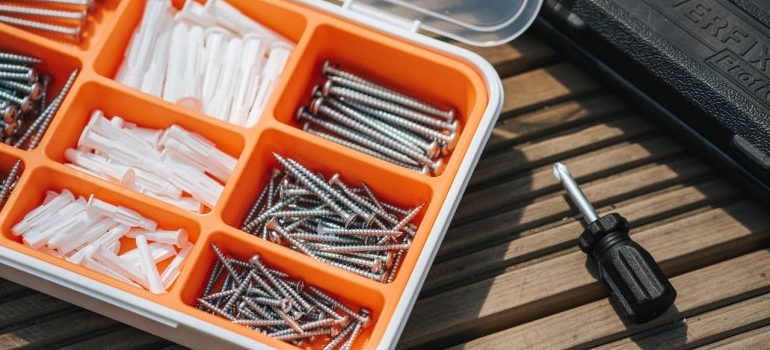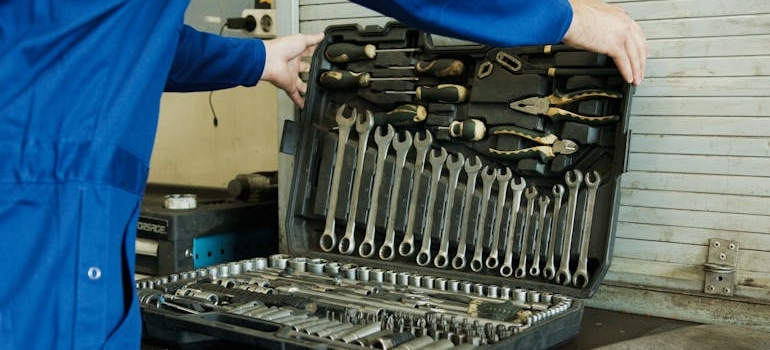Guide to storing work tools long-term
get a quote
Let’s face it: storing work tools for long-term use can seem like a chore. But, if you’ve ever returned to a rusted hammer or a dead drill after months of disuse, you know proper storage is essential. Tools are investments, and just like you wouldn’t leave a prized vehicle out in the elements, you shouldn’t leave your tools to deteriorate in a garage corner. So how do you ensure they stay in tip-top shape for the long haul? The answer to storing work tools long-term properly lies in preparation, protection, organization, and safekeeping in storage units North Seattle trusts. Therefore, look into these steps to keep your tools as sharp as the day you bought them.
Cleaning your tools: A necessary ritual
It’s tempting to throw tools in the toolbox after a long day, but every tool deserves a thorough cleaning for long-term storage. Dirt, grease, and moisture can accumulate on tools, leading to rust and degradation. Take the time to wipe each tool with a dry cloth.
If your tools have been exposed to water or humidity, consider a quick spritz of a rust-preventative oil. Rust is an enemy, especially for metal tools, and skipping this step is a quick path to costly replacements. Use compressed air or a small brush to clean out power tool vents and battery compartments.

Choosing the right storage location
Where you store your tools is just as important as how you store them. Humidity and fluctuating temperatures can wreak havoc on metal tools, causing rust and corrosion. A basement, attic, or shed might seem like good spots, but these locations often experience temperature extremes.
Ideally, tools should be stored in a controlled environment of Seattle mini storage that stays dry and temperate year-round. If climate control isn’t an option, you can use silica gel packs or dehumidifiers to keep moisture levels down, protecting your tools from rust.
For those without indoor storage, investing in waterproof and insulated storage cabinets can shield your tools from the worst of the elements. Ensure that tools are kept off the ground to avoid flood damage or contact with damp surfaces. Even a small toolbox can be elevated on a shelf to avoid water contact in case of spills or leaks.
Organize and protect: The layout of success
Let’s talk organization. Properly stored tools aren’t just easier to find; they’re also less likely to get damaged. Tools thrown haphazardly into a drawer or left in a pile are at risk of scratches, dents, or worse. You should aim to store tools either on pegboards, in labeled tool chests within portable storage containers Seattle recommends, or in dedicated tool cabinets.
Pegboards are a simple, space-saving solution that keeps everything visible but doesn’t leave tools unprotected from dust. Consider adding covers to prevent debris accumulation.

For smaller hand tools, use a toolbox with dividers, or invest in drawer liners that cushion and protect tools from rattling around. Large tools, particularly power tools, should be stored in their original cases when possible—these cases are designed to absorb shocks and prevent damage.
Shelving systems or wall-mounted racks are great for heavier, bulky equipment that doesn’t fit into traditional toolboxes. Going vertical with your storage setup can free up floor space while keeping your tools within easy reach.
Safety practices for storing work tools long-term
Storing tools securely isn’t just about protecting them from damage; it’s about ensuring they don’t end up in the wrong hands. Keeping sharp or heavy tools locked away is critical if, for instance, you have children at home. Similarly, if your tools are expensive or hold significant value, investing in cabinets with a lock or storage units can prevent theft. Hence, here’s a quick overview of key considerations:
- Use small containers to sort and store metal parts.
- Apply oil to metal tools to prevent rust.
- Keep power tools in their original cases.
- Label toolboxes for easy organization.
- Store valuable tools in lockable cabinets.
In fact, large-scale construction companies often deal with losses in the millions due to stolen tools. Keeping your tools under lock and key is a must, especially when stored in less secure environments like garages or outdoor sheds.
Maintaining power tool batteries
For those of you with battery-powered tools, the battery is where things often go wrong during long-term storage. One key point often overlooked when storing power tools is the battery’s charge level before packing. It’s recommended to store lithium-ion batteries at around 50% charge—not fully charged and not completely drained. It will prevent degradation and prolongs battery life.
Additionally, keep batteries in a cool, dry location, away from sunlight or heat sources. Heat is the nemesis of batteries, and extreme temperatures will quickly diminish their lifespan. It’s also essential to disconnect the batteries from the tools themselves during storage. That will avoid accidental power drains and prevent potential circuit damage during long stints of non-use.

Regular checks and maintenance
Even if you’re properly storing work tools long-term, you shouldn’t forget about them. Schedule periodic checks to ensure your tools are rust-free and in good shape. Rust can form even in seemingly dry conditions, and batteries can degrade if ignored. Inspect your tools for any signs of wear, rust, or corrosion and address any issues before they become major problems.
Also, be sure to lubricate moving parts on tools like wrenches, pliers, and power drills. It will prevent them from seizing up due to lack of use. If you’re storing power tools, remove any blades or attachments beforehand to prevent accidental damage to the tool or the attachment itself.
Care equals longevity
Proper long-term storage of your work tools isn’t just about putting them in your Bainbridge Island self storage; it’s about ensuring they remain functional and safe for years to come. Taking the time to clean and organize properly before storing work tools long-term helps extend their life and protect your investment. Instead of tossing that hammer into a drawer or leaving the cordless drill on a garage shelf, make sure your tools get the care they deserve. When your next project rolls around, both your tools and your wallet will thank you for it.
